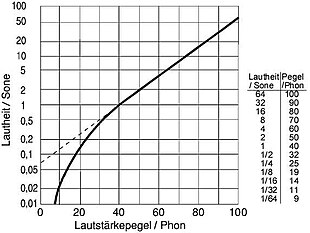Sone
| Physical unit | |
|---|---|
| Unit name | Sone |
| Unit symbol | |
| Physical quantity (s) | subjective loudness |
| Formula symbol | |
| dimension | |
| In SI units | |
The Sone [ soʊn ] is the psychoacoustic unit of measurement for the subjective loudness N of a sound event , which goes back to a suggestion by Stanley Smith Stevens in 1936. The Sone is not an SI unit or legal unit in the EU, but is defined by ISO 532 and used as a standard in jurisprudence.
definition
The definition of loudness N in Sone is based on the definition of the loudness level L N in Phon :
A volume level of 40 phons is assigned the loudness 1 sone. (A volume of 40 phon is defined as the volume of a sinusoidal tone with a frequency of 1 kHz and a sound pressure level of 40 dB SPL.) A sound that is felt twice as loud has a loudness of 2 sone, a sound that is four times as loud has a loudness of 4 sone and half as loud perceived sound as 0.5 sone.
Loudness> 1 sone
For loudnesses greater than 1 sone, i.e. for volume levels over 40 phons, each increase in the volume level by 10 phons leads to a doubling of the loudness value in sones (see figure).
In this area, the relationship between the loudness N in sone and the loudness level L N in phon can also be determined using the following simplified formula (ISO recommendation ISO / R 131-1959, dashed curve in the figure above):
Loudness <1 sone
For volume levels below 40 phons or loudnesses less than 1 sone, the above describes. Formula the perceived volume is no longer correct, here increasing / decreasing the volume level by less than 10 phons leads to a doubling / halving of the loudness impression.
detection
If you want to determine the loudness for noises other than sinusoidal tones, this must either be done by comparative listening tests or the perception of loudness by humans must be reproduced using appropriate mathematical models.
Standardized measuring methods for loudness measurement are described in DIN 45631 and ISO 532 B. These measuring methods determine either the loudness in sone or the volume level in phon.
Influences on volume perception
The volume perception of people and thus also the loudness in Sone depend on the sound pressure level , the frequency spectrum and the temporal structure of the sound. Therefore, sound signals with the same sound pressure level but different frequency spectrum and time behavior lead to very different loudnesses in sones.
The conversion of the sound signals into nerve impulses in the inner ear has a major influence on the loudness . Depending on the strength of the excitation of the nerve cells , a noise is judged louder or quieter. Loudness measurement methods therefore model the behavior of human hearing . One of the best known is Eberhard Zwicker's method , which is based on the modeling of masking effects.
A measurement of the loudness in sone makes sense if a sound immission is to be assessed. Several computer magazines measure the sound emitted by computers and their components and affecting people in Sone. In all measurements of noise disturbance, the focus is on the effect of sound on people.
Devices that are often running such as PCs and refrigerators in full load should be below 0.4 sone in the living and work area and, even better, below 0.1 sone in idle or partial load, in order to avoid disruptive continuous loads. Volume levels over 1 sone are often perceived as annoying and stressful.
Examples
Comparison of sound pressure in Pascal , unweighted sound pressure level in decibels (dB) and loudness in sone ( sound immission values ):
| Situation and source of sound |
Sound pressure p Pascal |
Sound pressure level L p dB re 20 µPa |
Loudness sone |
|---|---|---|---|
| Pain threshold | 100 Pa | 134 dB | ≈676 sone |
| Hearing damage from short-term exposure |
20 Pa | from 120 dB | ≈256 sone |
|
Jet plane 100 m away |
6.3-200 Pa | 110-140 dB | ≈128-1024 sone |
|
Jackhammer , 1 m / Disco |
2 Pa | ~ 100 dB | ≈64 sone |
Long-term exposure to hearing damage |
0.36 Pa | from 85 dB | ≈22 sone |
| Main road, 10 m away |
0.2-0.63 Pa | 80-90 dB | ≈16–32 sone |
| Car , 10 m away | 0.02-0.2 Pa | 60-80 dB | ≈4–16 sone |
|
TV in 1 m volume |
0.02 Pa | approx. 60 dB | ≈4 sone |
| Normal entertainment 1 m away |
2 · 10 −3 -6.3 · 10 −3 Pa | 40-50 dB | ≈1–2 sone |
| Very quiet room | 2 · 10 −4 -6.3 · 10 −4 Pa | 20-30 dB | ≈ 0.15-0.4 sone |
| Rustling leaves, calm breathing |
6.3 · 10 −5 Pa | 10 dB | ≈0.02 sone |
| Hearing threshold at 2 kHz | 2 · 10 −5 Pa | 0 dB | 0 sone |
| sone | 1 | 2 | 4th | 8th | 16 | 32 | 64 | 128 | 256 | 512 | 1024 |
|---|---|---|---|---|---|---|---|---|---|---|---|
| phon | 40 | 50 | 60 | 70 | 80 | 90 | 100 | 110 | 120 | 130 | 140 |






